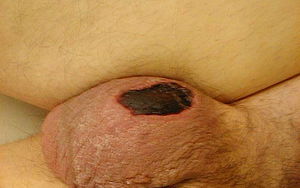
Fournier gangrene

Fournier gangrene is a type of necrotizing fasciitis or gangrene affecting the external genitalia and/or perineum. It commonly occurs in older men, but itcan also occur in women and children. It is more likely to occur in diabetics, alcoholics, or those who are immunocompromised. Fournier gangrene is a type of necrotizing fasciitis or gangrene affecting the external genitalia and/or perineum. It commonly occurs in older men, but itcan also occur in women and children. It is more likely to occur in diabetics, alcoholics, or those who are immunocompromised. About one per 62,500 males are affected per year. Males are affected about 40 times more often than females. It was first described by Baurienne in 1764 and is named after a French venereologist, Jean Alfred Fournier, following five cases he presented in clinical lectures in 1883. Initial symptoms of Fournier gangrene include swelling or sudden pain in the scrotum, fever, pallor, and generalized weakness. It is characterized by pain that extends beyond the border of the demarcated erythema. Most cases present mildly, but can progress in hours. Subcutaneous air is often one of the specific clinical signs, but is not seen in >50% of presenting clinical cases. More marked cases are characterized by a foul odor and necrotic infected tissue. Crepitus has been reported. It begins as a subcutaneous infection. However, necrotic patches soon appear in the overlying skin, which later develop into necrosis. Most cases of Fournier gangrene are infected with both aerobic and anaerobic bacteria. Lack of access to sanitation, medical care, and psychosocial resources has been linked to increased mortality. A 2006 Turkish study reported that blood sugar levels were elevated in forty-six percent of patients diagnosed with Fourniers. Another study reported that about one-third of patients were alcoholic, diabetic, and malnourished, while another ten percent had been immunosuppressed through chemotherapy, steroids, or malignancy. Fournier gangrene is a recognized side effect of SGLT2 inhibitors (canagliflozin, dapagliflozin, and empagliflozin), which increase the excretion of glucose in the urine. In the first six years after SGLT2 inhibitors were approved for the treatment of type 2 diabetes, fifty-five cases of Fournier gangrene were reported, in contrast to the nineteen cases that had been reported over thirty-five years in patients taking other classes of diabetes medications. Fournier gangrene is usually diagnosed clinically, but laboratory tests and imaging studies are used to confirm diagnosis, determine severity, and predict outcomes. X-rays and ultrasounds may show the presence of gas below the surface of the skin. A CT scan can be useful in determining the site of origin and extent of spread. Fournier gangrene is an urological emergency requiring intravenous antibiotics and debridement (surgical removal) of necrotic (dead) tissue. In addition to surgery and antibiotics, hyperbaric oxygen therapy may be useful and acts to inhibit the growth of and kill the anaerobic bacteria. While recent case series (n=9–80) studies have found a mortality rate of 20–40%, a large (n=1641) 2009 study reported a mortality rate of 7.5%.
